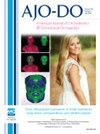Comparison of treatment effects with or without miniscrews for maxillary protraction in growing patients with Class III malocclusion
IF 3
2区 医学
Q1 DENTISTRY, ORAL SURGERY & MEDICINE
American Journal of Orthodontics and Dentofacial Orthopedics
Pub Date : 2025-05-02
DOI:10.1016/j.ajodo.2025.04.005
引用次数: 0
Abstract
Introduction
This study aimed to compare the skeletal and dental effects of maxillary protraction using a miniscrew-assisted rapid palatal expander (MARPE) and rapid palatal expander in growing patients with skeletal Class III malocclusion undergoing maxillary protraction.
Methods
This study included 18 patients in the facemask (FM) treatment with MARPE (group 1) and 20 patients in the FM treatment with rapid palatal expander (group 2). In addition, a control group (group 3) consisting of 21 patients undergoing no treatment affecting maxillary growth was established. Radiographic measurements were taken from lateral cephalometric radiographs at the start of FM treatment and after 3 months of treatment completion.
Results
Groups 1 and 2, receiving maxillary protraction treatment, exhibited significant increases in SNA (P <0.01) and ANB (P <0.001) values posttreatment, surpassing the control group. Group 1 showed a notably greater increase in SNA (P <0.001) and ANB (P <0.05) values than group 2. In contrast, group 2 demonstrated a significantly larger increase in FH-MP (P <0.001) and SN-U1 values (P <0.05). Both groups displayed significant advancement in the anterior border of the key ridge, the one-half point of the pterygomaxillary fissure, ANS, and point A after treatment, with group 1 showing a greater increase than group 2.
Conclusions
In treating severe maxillary hypoplasia or hyperdivergent skeletal patterns, MARPE appears to be more effective than tooth-borne expansion devices, offering greater skeletal effects with minimal dental and mandibular rotational effects.
使用或不使用微型支架治疗成长期III类错颌患者上颌前伸的疗效比较。
摘要:本研究旨在比较微型辅助快速腭扩张器(MARPE)和快速腭扩张器在骨性III类错颌生长患者行上颌前伸治疗中对骨骼和牙齿的影响。方法:采用MARPE进行面罩治疗的患者18例(1组),采用快速腭扩张器进行面罩治疗的患者20例(2组)。另设对照组(第三组),21例患者不接受任何影响上颌生长的治疗。在FM治疗开始时和治疗结束3个月后,从侧位头颅x线片进行放射测量。结果:第1组和第2组接受上颌牵引治疗后,SNA显著增加(P)。结论:在治疗严重上颌发育不全或骨骼过度分化的情况下,MARPE似乎比牙源性扩张装置更有效,可以在最小的牙齿和下颌旋转影响下提供更大的骨骼效果。
本文章由计算机程序翻译,如有差异,请以英文原文为准。
求助全文
约1分钟内获得全文
求助全文
来源期刊
CiteScore
4.80
自引率
13.30%
发文量
432
审稿时长
66 days
期刊介绍:
Published for more than 100 years, the American Journal of Orthodontics and Dentofacial Orthopedics remains the leading orthodontic resource. It is the official publication of the American Association of Orthodontists, its constituent societies, the American Board of Orthodontics, and the College of Diplomates of the American Board of Orthodontics. Each month its readers have access to original peer-reviewed articles that examine all phases of orthodontic treatment. Illustrated throughout, the publication includes tables, color photographs, and statistical data. Coverage includes successful diagnostic procedures, imaging techniques, bracket and archwire materials, extraction and impaction concerns, orthognathic surgery, TMJ disorders, removable appliances, and adult therapy.

 求助内容:
求助内容: 应助结果提醒方式:
应助结果提醒方式:


